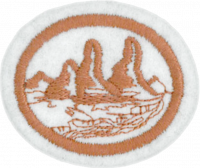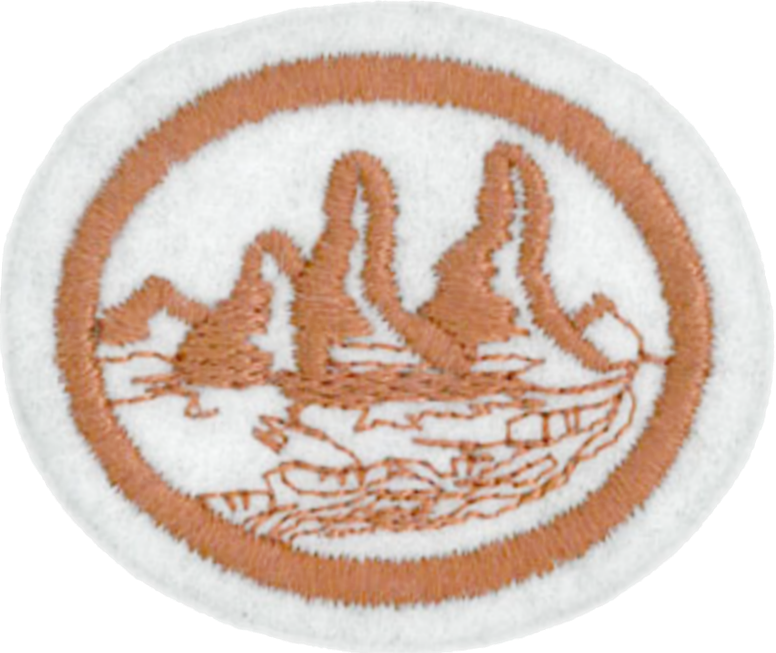Difference between revisions of "AY Honors/Geology/Answer Key/es"
From Pathfinder Wiki
(Created page with "</noinclude> Sedimentaria") |
(Updating to match new version of source page) |
||
| (40 intermediate revisions by 2 users not shown) | |||
| Line 1: | Line 1: | ||
| − | + | {{HonorSubpage}} | |
| − | + | <!--{{Honor_Master|honor=Geology|master=Conservation}}--> | |
| − | + | <section begin="Body" /> | |
| − | {{ | ||
| − | |||
| − | |||
| − | |||
| − | |||
| − | |||
| − | |||
| − | |||
| − | |||
| − | }} | ||
| − | |||
| − | {{Honor_Master | ||
| − | |||
| − | |||
| − | |||
| − | |||
| − | <section begin="Body" /> | ||
{{ansreq|page={{#titleparts:{{PAGENAME}}|2|1}}|num=1}} | {{ansreq|page={{#titleparts:{{PAGENAME}}|2|1}}|num=1}} | ||
<noinclude></noinclude> | <noinclude></noinclude> | ||
| − | <!-- 1. | + | <!-- 1. Dar el significado de las siguientes palabras: --> |
| − | |||
| − | |||
| − | |||
| − | |||
| − | |||
| − | |||
<noinclude></noinclude> | <noinclude></noinclude> | ||
{{ansreq|page={{#titleparts:{{PAGENAME}}|2|1}}|num=1a}} | {{ansreq|page={{#titleparts:{{PAGENAME}}|2|1}}|num=1a}} | ||
| Line 44: | Line 21: | ||
<noinclude></noinclude> | <noinclude></noinclude> | ||
| − | |||
| − | |||
| − | |||
| − | |||
| − | |||
| − | |||
<noinclude></noinclude> | <noinclude></noinclude> | ||
{{CloseReq}} <!-- 1d --> | {{CloseReq}} <!-- 1d --> | ||
| Line 55: | Line 26: | ||
<noinclude></noinclude> | <noinclude></noinclude> | ||
| − | + | <noinclude></noinclude> | |
| − | <noinclude | ||
| − | |||
{{CloseReq}} <!-- 1e --> | {{CloseReq}} <!-- 1e --> | ||
{{ansreq|page={{#titleparts:{{PAGENAME}}|2|1}}|num=1f}} | {{ansreq|page={{#titleparts:{{PAGENAME}}|2|1}}|num=1f}} | ||
<noinclude></noinclude> | <noinclude></noinclude> | ||
| − | + | <noinclude></noinclude> | |
| − | <noinclude | ||
| − | |||
{{CloseReq}} <!-- 1f --> | {{CloseReq}} <!-- 1f --> | ||
{{ansreq|page={{#titleparts:{{PAGENAME}}|2|1}}|num=1g}} | {{ansreq|page={{#titleparts:{{PAGENAME}}|2|1}}|num=1g}} | ||
<noinclude></noinclude> | <noinclude></noinclude> | ||
| − | + | <noinclude></noinclude> | |
| − | <noinclude | ||
| − | |||
{{CloseReq}} <!-- 1g --> | {{CloseReq}} <!-- 1g --> | ||
{{ansreq|page={{#titleparts:{{PAGENAME}}|2|1}}|num=1h}} | {{ansreq|page={{#titleparts:{{PAGENAME}}|2|1}}|num=1h}} | ||
<noinclude></noinclude> | <noinclude></noinclude> | ||
| − | |||
<noinclude></noinclude> | <noinclude></noinclude> | ||
{{CloseReq}} <!-- 1h --> | {{CloseReq}} <!-- 1h --> | ||
| Line 82: | Line 46: | ||
<noinclude></noinclude> | <noinclude></noinclude> | ||
| − | + | <noinclude></noinclude> | |
| − | <noinclude | ||
| − | |||
{{CloseReq}} <!-- 1i --> | {{CloseReq}} <!-- 1i --> | ||
{{ansreq|page={{#titleparts:{{PAGENAME}}|2|1}}|num=1j}} | {{ansreq|page={{#titleparts:{{PAGENAME}}|2|1}}|num=1j}} | ||
<noinclude></noinclude> | <noinclude></noinclude> | ||
| − | |||
<noinclude></noinclude> | <noinclude></noinclude> | ||
| Line 95: | Line 56: | ||
{{ansreq|page={{#titleparts:{{PAGENAME}}|2|1}}|num=2}} | {{ansreq|page={{#titleparts:{{PAGENAME}}|2|1}}|num=2}} | ||
<noinclude></noinclude> | <noinclude></noinclude> | ||
| − | <!-- 2. | + | <!-- 2. Describir los siguientes puntos: --> |
<noinclude></noinclude> | <noinclude></noinclude> | ||
{{ansreq|page={{#titleparts:{{PAGENAME}}|2|1}}|num=2a}} | {{ansreq|page={{#titleparts:{{PAGENAME}}|2|1}}|num=2a}} | ||
<noinclude></noinclude> | <noinclude></noinclude> | ||
| − | |||
| − | |||
| − | |||
| − | + | {{clear}} | |
| − | |||
| − | |||
<noinclude></noinclude> | <noinclude></noinclude> | ||
| Line 111: | Line 67: | ||
{{ansreq|page={{#titleparts:{{PAGENAME}}|2|1}}|num=2b}} <!--T:11--> | {{ansreq|page={{#titleparts:{{PAGENAME}}|2|1}}|num=2b}} <!--T:11--> | ||
<noinclude></noinclude> | <noinclude></noinclude> | ||
| − | |||
| − | + | {{clear}} | |
| − | + | {{clear}} | |
| − | + | {{clear}} | |
<noinclude></noinclude> | <noinclude></noinclude> | ||
| Line 123: | Line 78: | ||
{{ansreq|page={{#titleparts:{{PAGENAME}}|2|1}}|num=2c}} <!--T:15--> | {{ansreq|page={{#titleparts:{{PAGENAME}}|2|1}}|num=2c}} <!--T:15--> | ||
<noinclude></noinclude> | <noinclude></noinclude> | ||
| − | |||
| − | + | {{clear}} | |
<noinclude></noinclude> | <noinclude></noinclude> | ||
| Line 131: | Line 85: | ||
{{ansreq|page={{#titleparts:{{PAGENAME}}|2|1}}|num=2d}} <!--T:17--> | {{ansreq|page={{#titleparts:{{PAGENAME}}|2|1}}|num=2d}} <!--T:17--> | ||
<noinclude></noinclude> | <noinclude></noinclude> | ||
| − | |||
| − | |||
| − | |||
| − | |||
| − | |||
| − | |||
| − | |||
| − | |||
| − | |||
| − | |||
| − | + | {{clear}} | |
| − | |||
| − | |||
| − | |||
| − | + | {{clear}} | |
<noinclude></noinclude> | <noinclude></noinclude> | ||
| Line 153: | Line 94: | ||
{{ansreq|page={{#titleparts:{{PAGENAME}}|2|1}}|num=2e}} <!--T:20--> | {{ansreq|page={{#titleparts:{{PAGENAME}}|2|1}}|num=2e}} <!--T:20--> | ||
<noinclude></noinclude> | <noinclude></noinclude> | ||
| − | |||
<noinclude></noinclude> | <noinclude></noinclude> | ||
| Line 160: | Line 100: | ||
{{ansreq|page={{#titleparts:{{PAGENAME}}|2|1}}|num=3}} | {{ansreq|page={{#titleparts:{{PAGENAME}}|2|1}}|num=3}} | ||
<noinclude></noinclude> | <noinclude></noinclude> | ||
| − | <!-- 3. | + | <!-- 3. Saber qué clase de rocas (sedimentarias, metamórficas, o ígneas) son las siguientes: --> |
| − | |||
| − | |||
| − | |||
| − | |||
<noinclude></noinclude> | <noinclude></noinclude> | ||
| Line 181: | Line 117: | ||
{{ansreq|page={{#titleparts:{{PAGENAME}}|2|1}}|num=3c}} | {{ansreq|page={{#titleparts:{{PAGENAME}}|2|1}}|num=3c}} | ||
<noinclude></noinclude> | <noinclude></noinclude> | ||
| − | + | Sedimentaria | |
<noinclude></noinclude> | <noinclude></noinclude> | ||
| Line 187: | Line 123: | ||
{{ansreq|page={{#titleparts:{{PAGENAME}}|2|1}}|num=3d}} | {{ansreq|page={{#titleparts:{{PAGENAME}}|2|1}}|num=3d}} | ||
<noinclude></noinclude> | <noinclude></noinclude> | ||
| − | + | Metamórfica | |
<noinclude></noinclude> | <noinclude></noinclude> | ||
| Line 193: | Line 129: | ||
{{ansreq|page={{#titleparts:{{PAGENAME}}|2|1}}|num=3e}} | {{ansreq|page={{#titleparts:{{PAGENAME}}|2|1}}|num=3e}} | ||
<noinclude></noinclude> | <noinclude></noinclude> | ||
| − | + | Sedimentaria | |
<noinclude></noinclude> | <noinclude></noinclude> | ||
| Line 199: | Line 135: | ||
{{ansreq|page={{#titleparts:{{PAGENAME}}|2|1}}|num=3f}} | {{ansreq|page={{#titleparts:{{PAGENAME}}|2|1}}|num=3f}} | ||
<noinclude></noinclude> | <noinclude></noinclude> | ||
| − | + | Metamórfica | |
<noinclude></noinclude> | <noinclude></noinclude> | ||
| Line 211: | Line 147: | ||
{{ansreq|page={{#titleparts:{{PAGENAME}}|2|1}}|num=3h}} | {{ansreq|page={{#titleparts:{{PAGENAME}}|2|1}}|num=3h}} | ||
<noinclude></noinclude> | <noinclude></noinclude> | ||
| − | + | Sedimentaria | |
<noinclude></noinclude> | <noinclude></noinclude> | ||
| Line 223: | Line 159: | ||
{{ansreq|page={{#titleparts:{{PAGENAME}}|2|1}}|num=3j}} | {{ansreq|page={{#titleparts:{{PAGENAME}}|2|1}}|num=3j}} | ||
<noinclude></noinclude> | <noinclude></noinclude> | ||
| − | + | Metamórfica | |
<noinclude></noinclude> | <noinclude></noinclude> | ||
| Line 230: | Line 166: | ||
{{ansreq|page={{#titleparts:{{PAGENAME}}|2|1}}|num=4}} | {{ansreq|page={{#titleparts:{{PAGENAME}}|2|1}}|num=4}} | ||
<noinclude></noinclude> | <noinclude></noinclude> | ||
| − | <!-- 4. | + | <!-- 4. Tomar una fotografía o realizar un boceto de cada una de las siguientes características geológicas: --> |
<noinclude></noinclude> | <noinclude></noinclude> | ||
{{ansreq|page={{#titleparts:{{PAGENAME}}|2|1}}|num=4a}} | {{ansreq|page={{#titleparts:{{PAGENAME}}|2|1}}|num=4a}} | ||
<noinclude></noinclude> | <noinclude></noinclude> | ||
| − | |||
| − | |||
| − | |||
<noinclude></noinclude> | <noinclude></noinclude> | ||
| Line 242: | Line 175: | ||
{{ansreq|page={{#titleparts:{{PAGENAME}}|2|1}}|num=4b}} <!--T:24--> | {{ansreq|page={{#titleparts:{{PAGENAME}}|2|1}}|num=4b}} <!--T:24--> | ||
<noinclude></noinclude> | <noinclude></noinclude> | ||
| − | |||
| − | |||
| − | |||
<noinclude></noinclude> | <noinclude></noinclude> | ||
| Line 250: | Line 180: | ||
{{ansreq|page={{#titleparts:{{PAGENAME}}|2|1}}|num=4c}} <!--T:25--> | {{ansreq|page={{#titleparts:{{PAGENAME}}|2|1}}|num=4c}} <!--T:25--> | ||
<noinclude></noinclude> | <noinclude></noinclude> | ||
| − | |||
| − | |||
| − | |||
<noinclude></noinclude> | <noinclude></noinclude> | ||
| Line 258: | Line 185: | ||
{{ansreq|page={{#titleparts:{{PAGENAME}}|2|1}}|num=4d}} <!--T:26--> | {{ansreq|page={{#titleparts:{{PAGENAME}}|2|1}}|num=4d}} <!--T:26--> | ||
<noinclude></noinclude> | <noinclude></noinclude> | ||
| − | |||
| − | |||
<noinclude></noinclude> | <noinclude></noinclude> | ||
| Line 266: | Line 191: | ||
<noinclude></noinclude> | <noinclude></noinclude> | ||
| − | + | {{clear}} | |
| − | + | {{clear}} | |
| − | + | {{clear}} | |
| − | + | {{clear}} | |
| − | + | {{clear}} | |
| − | + | {{clear}} | |
| − | |||
<noinclude></noinclude> | <noinclude></noinclude> | ||
| Line 283: | Line 207: | ||
{{ansreq|page={{#titleparts:{{PAGENAME}}|2|1}}|num=4f}} <!--T:34--> | {{ansreq|page={{#titleparts:{{PAGENAME}}|2|1}}|num=4f}} <!--T:34--> | ||
<noinclude></noinclude> | <noinclude></noinclude> | ||
| − | |||
| − | |||
<noinclude></noinclude> | <noinclude></noinclude> | ||
| Line 290: | Line 212: | ||
{{CloseReq}} <!-- 4 --> | {{CloseReq}} <!-- 4 --> | ||
<noinclude></noinclude> | <noinclude></noinclude> | ||
| − | == | + | ==Referencias== |
| − | |||
| − | |||
| − | |||
| − | |||
| − | |||
| − | |||
| − | |||
| − | |||
| − | |||
| − | |||
| − | |||
| − | |||
| − | |||
| − | |||
| − | |||
| − | |||
| − | |||
| − | |||
<noinclude></noinclude> | <noinclude></noinclude> | ||
| − | + | ||
| + | [[Category:Adventist Youth Honors Answer Book/Do at home{{GetLangSuffix}}]] | ||
| + | {{CloseHonorPage}} | ||
Latest revision as of 01:44, 4 January 2023
1
Dar el significado de las siguientes palabras:
1a
Delta
1b
Banco de arena
1c
Hundimiento de tierra
1d
Lago en un meandro (forma de herradura)
1e
Morrena
1f
Circo glaciar
1g
Meseta
1h
Abanico aluvial
1i
Anticlinal
1j
Sinclinal
2
Describir los siguientes puntos:
2a
Un volcán tipo escudo, en comparación a un volcán compuesto
2b
¿Cómo se mueve un glaciar y qué evidencias deja atrás?
2c
¿Cómo son los sedimentos establecidos por agua?
2d
Las diferentes clases de montañas
2e
¿Por qué un río o arroyo continua a menudo cavando en el exterior de una curva?
3
Saber qué clase de rocas (sedimentarias, metamórficas, o ígneas) son las siguientes:
3a
Granito
Ígnea
3b
Arenisca
Sedimentaria
3c
Conglomerado
Sedimentaria
3d
Esquito (pizarra)
Metamórfica
3e
Pizarra (roca)
Sedimentaria
3f
Mármol
Metamórfica
3g
Lava
Ígnea
3h
Caliza
Sedimentaria
3i
Basalto
Ígnea
3j
Gneis
Metamórfica
4
Tomar una fotografía o realizar un boceto de cada una de las siguientes características geológicas:
4a
Una cama de sedimento que es más tosca en la parte inferior y más fina hacia la parte superior (esto se llama sedimento normalmente graduado).
4b
Marcas de ondas en la arena o el barro (mostrar con una flecha la dirección de la corriente si es posible).
4c
Erosión en forma de canal.
4d
Grietas de barro (estas pueden ser encontradas por lo general después de una tormenta o inundación cuando el lodo comienza a secarse).
4e
Perfil del suelo a lo largo de un arroyo o de un corte de carretera (debe poder ver cómo se convierte por lo general en colores claros bajo de la superficie en el terreno).
4f
Banco de arena (barras de arena se pueden encontrar en los ríos o arroyos, o a lo largo del océano).


